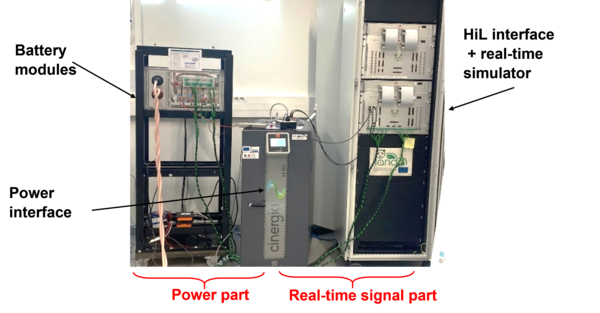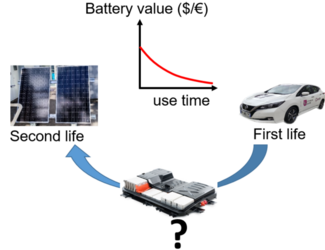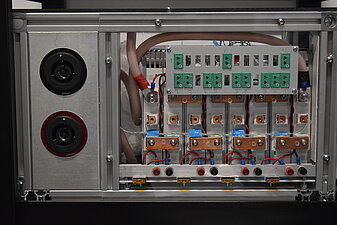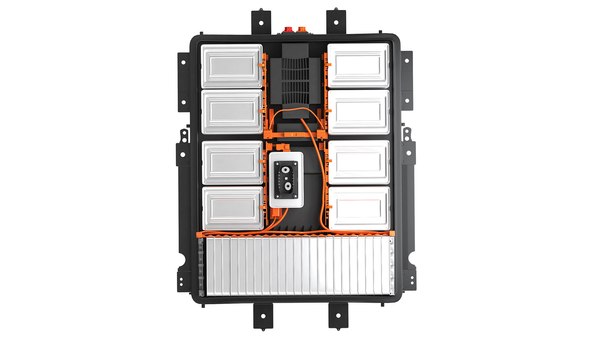E-storage
E-Storage
The objective of the workspace is to systematically study the Energy Storage sub-Systems (ESSs) used in electric (EVs) or hybrid (HEVs) vehicles.
The considered energy storage systems are batteries and super capacitors. A demonstration fuel cell is also available.
There are a variety of Lithium-ion batteries with different chemistries. They correspond to the most used in electrified vehicles (NMC, LMO, LFP). Some modules are high-power, they correspond to HEVs use. Some modules are high-energy, they are used in EVs. All modules are instrumented for electrical and thermal measurements. The platform also includes a full-sized 40 kWh Nissan Leaf battery.
The studied applications are the following:
- management of multiple energy sources,
- power HIL test for ESSs in electrified vehicles,
- power tests for charging, driver in the loop (DIL) testing.
eCAMPUS project
The International Associate Laboratory (IAL) eCAMPUS (Electro-mobility for CAMPus of Universities based on Sustainability). eCAMPUS was born from a collaboration between the University of Lille and the University of Québec à Trois-Rivières (UQTR) (Fig 1).

The different logo of the partners of the projects are displayed
The E-storage workspace is used for the Axis 3 of the LAI (Analysis of the consumption and recharge of electric vehicles, coordinated by the L2EP) through Hardware In the Loop (HIL) tests in charging and driving mode (Fig. 2).

Shows the battery HiL test bench. It founds the battery pack conneced to the power amplifier to exchange power.
Therefore, dfifferent temperatures can be studied with a thermal chamber (Fig. 3).

Shows the thermo-climatic room for testing the module's cells and battery under specific temperature conditions.
Exemple of energy storage available
| Characteristic battery | Value |
|---|---|
| Technoogy | NMC |
| Structure | 4 pairs of cells in series (8) |
| Nominal voltage | 14.6V |
| Size | 30 x 22.2 x 6.8 cm |
| Weight | 8.7 kg |
Contact
Associate Prof. Ronan German,
Ronan.German@univ-lille.fr,
University of Lille
Project linked to energy storage applications
PANDA H2020 European project: Powerful Advanced N level Digital Architecture for models of electrified vehicles and their components
The project was leaded by the university of Lille and uses the E-storage workspace of the EV platform from 2018 to 2022.
In PANDA, a method has been developed to organise and interconnect models for electrical vehicle (EV) components. Traditionally, internal combustion engines are developed (to a certain extent) independently from the vehicles. In electrified vehicles, all systems are more integrated, making it fundamentally more complex to design an EV. Using the PANDA approach all electrical components in an EV can be combined in a single model. Designers can quickly investigate new architectures and components, without having to build a physical prototype first. The method is based on the Energetic Macroscopic Representation (EMR) formalism. In PANDA a cloud of EMR-based models has been developed with a battery electric vehicle (BEV), a fuel-cell vehicle (FCEV) and a plug-in hybrid electric vehicle (PHEV).
The experimental workspace has been used to develop power HIL tests of batteries for EVs and HEVs. Usually, the test is located in a unique place (local HIL). Cloud model sharing is developed to spare time and cloud-based real-time simulation limits the access to the models to only certain variables. For cloud-based HIL, the models are simulated on the cloud and the power part of the test is implemented in the E-storage workpace of the EV platform (Fig 1.). The Energetic Macroscopic Representation (EMR) is used as a common formalism to organize all the models and the test.

Funders

TESSA project
Techno-Economical Study of Second life batteries for Affordable e-mobility campus
TESSA project seeks to develop a flexible technical economic and environmental model of second life applications for used electric vehicle (EV) batteries. The proposed work brings together highly detailed technical models of battery operation and ageing, economic analysis of energy systems, life-cycle assessment, and data on EV driver preferences.
This interdisciplinary approach will be used to improve the economics and carbon benefits of second life EV batteries, to understand the ideal time for drivers to replace their EV battery, and assess the overall benefits of EV battery secondary uses. The project is connected to the CUMIN program at the University of Lille, making use of the existing research capabilities while contributing new analytical tools.
The first study case will be applied to the “Cité Scientifique” campus of University of Lille, with its future EV fleet and charging stations supplied by renewable energy. After this first case study, extensions will be developed for France, Europe, USA and the world.

Partner

Funders



